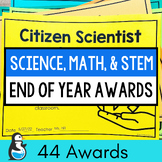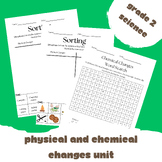188 results
Physical science lectures for Microsoft Word
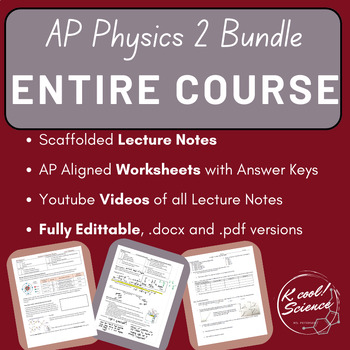
Entire AP Physics 2 Curriculum- Notes, Practices, and Video Lectures!
This bundle includes:Scaffolded Lecture Notes- designed to have space to write and annotate as the teacher lectures, writing along with the students as they go. These are developed from the Course and Exam Description, the Cutnell-Johnson textbook, AP Physics 2 prep books, Bigler Notes, and more to teach the content in a concise, straightforward, and effective manner.Practice Worksheets + KEYs- For each lecture, a matching practice where students extend and practice their skills in both AP level
Subjects:
Grades:
10th - 12th

Advanced Chemistry Course Notes Bundle
This substantial bundle has all of the lecture notes/PowerPoints necessary for a 16-unit advanced chemistry course. Each PowerPoint contains additional practice and suggestions for review, in addition to having a set of Guided Practice Questions for each unit that follows the instruction provided within the PowerPoints.
Subjects:
Grades:
9th - 12th, Higher Education
NGSS:
HS-PS1-1
, HS-PS3-2
, HS-PS1-4
, HS-PS1-6
, HS-PS3-1
...

Ionic Charges Lesson: Slides, Doodle Notes, Inquiry, Homework,Warmup/Exit Ticket
Ionic Charges Complete 5E Lesson Bundle: Powerpoint, doodle notes, inquiry activity, warmup/exit ticket , and homework/worksheet for ions, ionic charge, and intro to ionic bonding. This lesson follows the 5E's along with NGSS and includes everything that you need to teach a lesson about ionic charges! This hassle free lesson is sure to engage your students through many different activities. Also, this lesson contains many items that are both digital and print compatible!Students will learn about
Subjects:
Grades:
9th - 12th, Higher Education
Types:
NGSS:
HS-PS1-1
![Preview of Chemistry Acids and Bases Full Unit Guided Notes, Examples, Practice [15 pages!]](https://ecdn.teacherspayteachers.com/thumbitem/Chemistry-Acids-and-Bases-Full-Unit-Guided-Notes-Examples-Practice-15-pages--11269401-1710589016/original-11269401-1.jpg)
Chemistry Acids and Bases Full Unit Guided Notes, Examples, Practice [15 pages!]
The 15-page Chemistry Acids and Bases Full Unit Guided Notes Examples, and Practice is entirely customizable. The guided notes are designed to go along with the PowerPoint, but could be used as a stand alone product. This 15 page guided notes set covers all parts of the Acids and Bases unit and has problems that comprehensively cover:Acid-Base vocabulary and propertiesAcid-Base theories Acid nomenclature Concept of strong acids/bases visuallyThe pH Scale Calculations with pH, pOH, [H+] and [OH-]
Subjects:
Grades:
8th - 11th
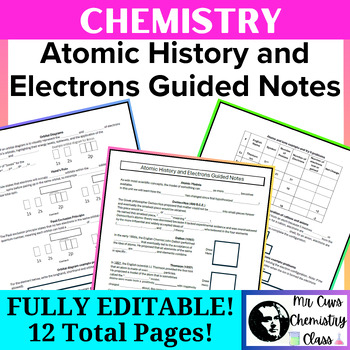
Chemistry Atomic History (Theory) and Electrons Full Unit Guided Notes
The Chemistry (or physical science) 12-page Atomic History (Theory) and Electrons Full Unit Guided Notes (atoms, electrons and electron configurations, orbital diagrams, ions, the electromagnetic spectrum + more!) covers all parts of the listed topics and has notes/examples/problems that comprehensively covers:Atomic Models (Bohr etc.) and Atomic HistoryElectron orbitalsElectron configuration of atoms (longhand and shorthand)Orbital diagrams of atomsLewis structures of atomsConcept of an atom vs
Subjects:
Grades:
8th - 11th
Types:

Chemistry Introduction to Chemistry Guided Notes (Dimensional Analysis + more!)
The 13-page Introduction to Chemistry Guided Notes (Dimensional Analysis, density, temperature scales + more) covers all parts of the first unit of chemistry and has notes/examples/problems that comprehensively covers:Significant figuresScientific notationSystems of measurementDimensional analysisTemperature scales (includes thermometer reading and calculations)DensityAccuracy and precisionPercent errorThe enclosed document is entirely customizable for you add any examples/problems or remove any
Subjects:
Grades:
8th - 11th
Types:

Chemistry Matter and Basic Atomic Theory Full Unit Guided Notes
The Chemistry (or physical science) 12-page Matter and Basic Atomic Theory Guided Notes (properties, changes, mixtures, phase changes and diagrams, atomic theory + more!) covers all parts of the second unit of chemistry and has notes/examples/problems that comprehensively covers:Basic chemistry concepts - Matter, elements, compounds, pure substances and mixtures including particulate diagrams!Heterogenous and homogenous mixturesChemical and physical propertiesChemical and physical changesKinetic
Subjects:
Grades:
8th - 11th
Types:
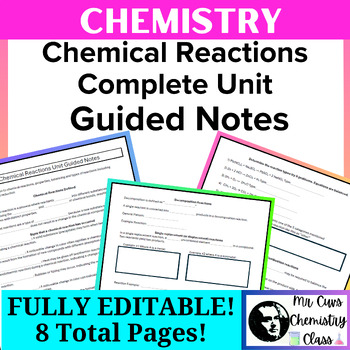
Chemistry Physical Science Chemical Reactions (equations) Full Unit Guided Notes
The 8-page Chemistry Physical Science Chemical Reactions (equations) Full Unit Guided Notes covers all parts of chemical reactions and has notes/examples/problems that comprehensively covers:Basics of chemical reactions including vocabularyBalancing equations step-by-step without polyatomic ionsBalancing equations step-by-step with polyatomic ionsTypes of reactions (synthesis, decomposition, single replacement, double replacement, combustion of organics)Balancing carbon-based combustion reaction
Subjects:
Grades:
8th - 11th
Types:
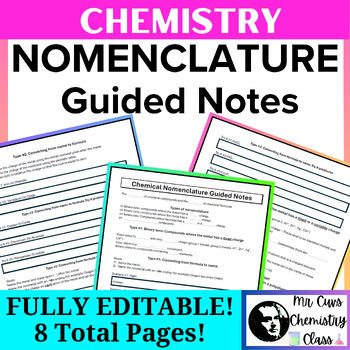
Chemistry Physical Science Chemical Nomenclature Full Unit Guided Notes
The 8-page Chemistry Physical Science Chemical Nomenclature [Naming & Formula Writing (Ionic + Molecular Compounds)] Full Unit guided notes covers all parts of nomenclature and has examples/problems that comprehensively covers:Binary Ionic Nomenclature of metals with a fixed chargeBinary Ionic Nomenclature of metals with a variable chargeTernary ionic compoundsCovalent nomenclature using the prefix system (mono, di, tri etc.)The enclosed document is entirely customizable for you add any exam
Subjects:
Grades:
8th - 11th
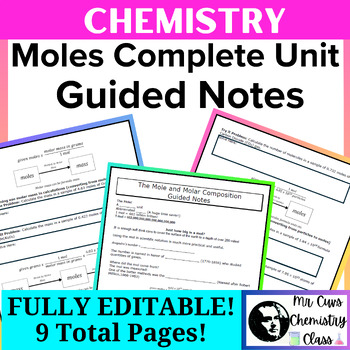
Chemistry Physical Science Moles Molar Composition Full Unit Guided Notes
The 9-page Chemistry Physical Science Moles Molar Composition Full Unit Guided Notes Unit covers all parts of the mole, molar composition and has problems that comprehensively covers:The Mole Molar Mass Molar Mass calculations [Mass to moles (1-step) and Moles to mass (1-step)]Avogadro's number [Particles to moles (1-step) and Mass to particles (2-step) and Particles to mass (2-step)]Percent compositionEmpirical formulas Molecular formulasIf you are interested in a PowerPoint, a review, a test (
Subjects:
Grades:
8th - 11th
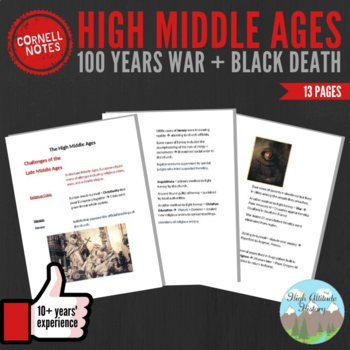
Cornell Notes: High Middle Ages (100 Years War + Black Death)
Cornell, or two-column, notes are a great way to improve metacognition, as well as organizational skills. Notes include charts, graphs, photographs, primary sources, colored detail, vocabulary, and definitions, depending on the section. Check back frequently, as notes sections are added daily. My Cornell notes are perfect for in-class presentations and as handouts to be used to complete Venn diagrams or flow charts, and vary depending on the particular section. Look for Cornell notes sections co
Subjects:
Grades:
9th - 12th
Types:
Also included in: Middle Ages Cornell Notes Bundle
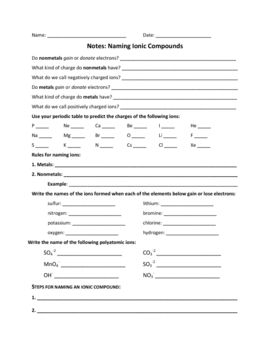
Naming Compounds Notes Set
These notes coincide with the Naming Compounds PowerPoint that is also available. They allow students to follow along with all 4 PowerPoints: Naming Ionic Compounds, Naming Binary Covalent Compounds, Naming Ionic and Covalent Compounds Review and Naming Acids and Bases. They include plenty of student practice that will allow teachers to check for understanding throughout each lesson.
Subjects:
Grades:
8th - 12th
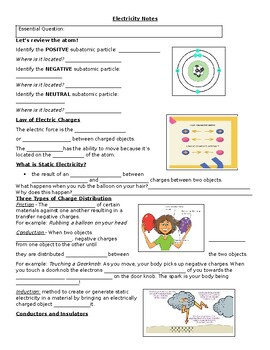
Electricity and Magnetism Notes
Electricity and Magnetism fill in the blank notes. Grab the matching Canva slides on my page as well!
Subjects:
Grades:
8th

StayGiant Physics Bundle: Electricity
Electric Charge, Electric Force, and DC CircuitsSs begin an exploration of electricity by learning about the electric force and the properties and interactions of electric charges. Ss continue by examining electric circuits and the interactions between current, resistance, and voltage.Topics include:Conservation of chargeElectric chargeElectric forceDefinition of a circuitResistivityOhm’s law, Kirchhoff’s loop rule (resistors in series and parallel)Kirchhoff’s junction rule, Ohm’s law (resistors
Subjects:
Grades:
8th - 12th, Higher Education
NGSS:
MS-PS3-2
, HS-PS3-1
, HS-PS3-5
, 4-PS3-2
, HS-PS3-3

Why is energy needed?
Digital, interactive presentation, with included games for self-testing.Topics: What is energy?, How is energy produced - 4 sources of natural energy are examined. Types of energy - electricity is discussed in more detail, 4 ways of obtaining electricity are illustrated. Battery as an energy source. Energy of motion. Thermal energy - what are heat sources and what are heat retainers. How to save electricity? How to save heat energy?The presentation has a lot of visual illustrations - pictures, v
Subjects:
Grades:
3rd - 4th

Question Exploration: What is acid? What is base? How does the pH scale work?
In Chemistry, adding 1 to 13 equals 7 (and salt) -- when Ss measure the pH of acids, bases and neutrals! What are some general properties of acids, bases, and neutral solutions? How does the pH scale work to rate acidity and alkaline?These Content Enhancement Routines include Question Explorations to ask the Essential Question: What is an acid? What is a base? What is the pH scale? The Concept Comparison Frame contrasts the pH scale and the potential of a substance's solution to form Hydrogen io
Subjects:
Grades:
8th - 10th
NGSS:
HS-PS1-1
, MS-PS1-2
, HS-PS1-7
, HS-PS1-2
, MS-PS1-1
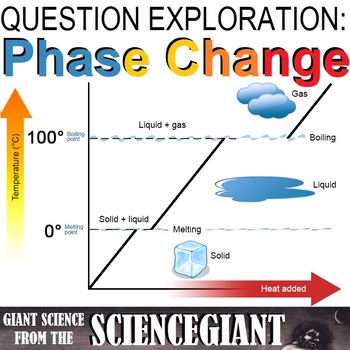
Question Explore: How Does Matter Change State During a Phase Change?
The water cycle is one example of matter changing state, as a liquid evaporates, and the vapor condenses back into a liquid, or freezes into a solid, which precipitates and melts. This question exploration helps Ss explain How Does Matter Change State During a Phase Change?The Question Exploration Routine is an instructional methods that teachers can use to help a diverse student population understand a body of content information by carefully answering a critical question to arrive at a main id
Subjects:
Grades:
7th - 12th
Types:
NGSS:
MS-PS1-4
, MS-PS1-2
, HS-PS1-5
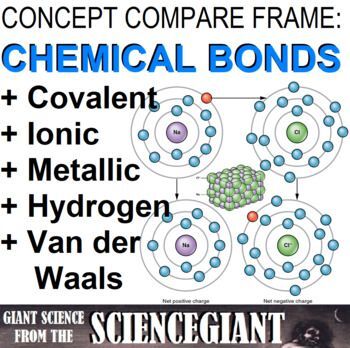
Concept Comparison and Frame: Ionic, Covalent, and Metallic Bonds in Molecules
This concept comparison is between chemical bonding of molecules and compounds. Help Ss contrast ionic and covalent bonding, as well as metallic bonds and Van der Waals forces (hydrogen bonds, dipole-dipole, London dispersion and Debye) . Also includes a chemical bond triangle graphic to help visualize differences in electronegativity The Concept Comparison Routine is used help compare and contrast key concepts. Specifically, students use like and unlike characteristics and categories shared an
Subjects:
Grades:
8th - 10th, Higher Education
NGSS:
HS-PS1-4
, HS-PS1-2
, MS-PS1-1

Atomic Theory Unit Notes Bundle
In this bundle you will find four PowerPoint presentations & two accompanying handouts, teaching students about atomic structure and theory. This notes bundle will go into detail concerning Dalton's atomic theory, our understanding of isotopes, the work of J.J. Thomson, William Thomson, Ernest Rutherford, Niels Bohr and the contributors to the Wave Mechanical Model, in addition to an explanation of how to write ground, excited and valence electron configurations and representing electron co
Subjects:
Grades:
9th - 12th, Higher Education
NGSS:
HS-PS1-1
, HS-PS4-1
, HS-PS1-2
, HS-PS4-3
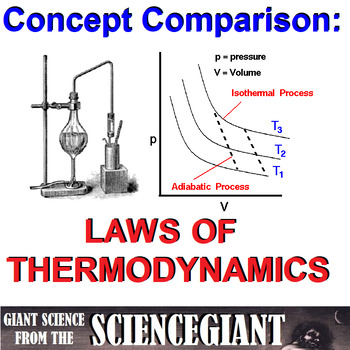
Concept Comparison Frame: Laws of Thermodynamics
What are Laws of Thermodynamics? This concept comparison introduces Ss to the laws of the thermodynamics, pressure-volume diagrams for ideal gases, processes which are isothermal, isovolumetic, and adiabatic, and explains differences in enthropy and enthalpy. Through inquiry and exploration, students will describe how the law of conservation of energy dictates how heat energy is transferred through systems by convection, conduction, and radiation, its influences on changes of states of matter an
Subjects:
Grades:
9th - 12th, Higher Education
Types:
NGSS:
MS-PS3-4
, HS-PS3-4
, HS-PS3-2
, MS-PS3-3
Also included in: StayGiant Physics Bundle: Thermal Energy

Balancing & Classifying Reactions Unit Notes Bundle
In this bundle you will find four PowerPoint presentations & one accompanying handout, teaching students about balancing equations & classifying reactions. This notes bundle will go into detail concerning what information is present within a chemical equation, how to balance equations, the driving forces for chemical reactions, precipitation reactions, solubility rules, acid-base reactions, how to represent reactions that occurred within a solution using molecular, ionic and net ionic e
Subjects:
Grades:
9th - 12th, Higher Education
NGSS:
HS-PS1-7
, HS-PS1-2

Bonding & Lewis Structures Unit Notes Bundle
In this bundle you will find three PowerPoint presentations & one accompanying handout, teaching students about chemical bonding, Lewis Structures, the VSEPR model and the molecular and electron pair geometry naming systems. This notes bundle will go into detail concerning the definition of intramolecular forces, the formation and differences between ionic and covalent bonding, the atomic property of electronegativity, representing bond polarity through the use of dipole moments, molecular
Subjects:
Grades:
9th - 12th, Higher Education
NGSS:
HS-PS1-4
, HS-PS1-3
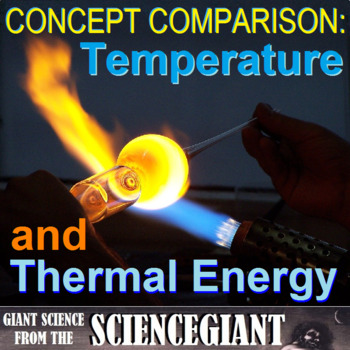
Concept Comparison: Temperature vs Thermal Energy
This Concept Comparison contrasts thermal energy and temperature as they relate to heat transfer. It builds from middle school science concepts of mechanical energy, and an introduces specific heat capacity and the laws of thermodynamics.The Concept Comparison Routine is used help compare and contrast key concepts. Specifically, students use like and unlike characteristics and categories shared and not shared by two or more concepts to better understand the overall concept. Students taught using
Subjects:
Grades:
7th - 12th, Higher Education
NGSS:
HS-PS1-4
, MS-PS1-4
, HS-PS1-5
, MS-PS1-6
Also included in: StayGiant Physics Bundle: Thermal Energy
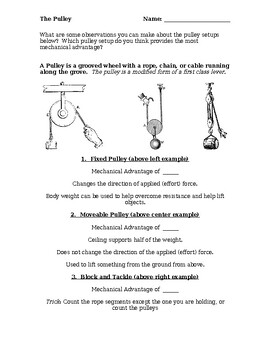
Physics: The Pulley Guided Student Notes (Fixed, Moveable, Block & Tackle)
This MS-Word handout helps guide a lesson on pulleys as part of a physics simple machine unit or Rube Goldberg project. Two levels of guided student notes are provided, the first for limited note taking for special needs students, and the second for typical students who can take full lesson notes. Since this is a word document, you can modify the level of detail you want students to take or fill-in. This is a great handout to use as a lesson exit ticket. The entire handout is can be previewe
Subjects:
Grades:
7th - 10th
Showing 1-24 of 188 results


